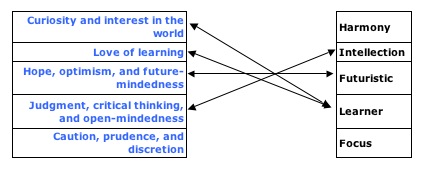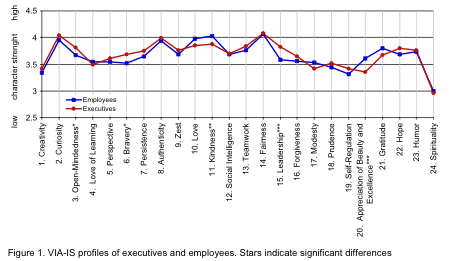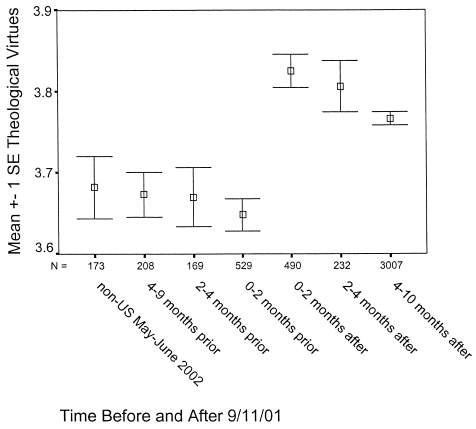These two dominant models of strengths are slightly different in concept. Gallup’s Strengthsfinder is more workplace-oriented, helping people to do better in their careers and organisations to work better. Perhaps performance-oriented is a better term. Values In Action (VIA), which we looked at in depth earlier, is character-oriented, helping people to achieve virtue.
First of all, I should say that StrengthsFinder doesn’t measure something Gallup calls ‘strengths’. They measure ‘talents’, which are defined as natural ways of thinking and behaving, and by adding skills and knowledge, they say talents can become strengths, which they define as consistent near-perfect performance. Since SF talends and VIA strengths are the same thing, I’ll just call talents strengths for consistency.
Given these basic conceptual differences, I wondered whether their respective questionnaires would return slightly different results. If you look at the list of strengths below, you’ll notice there are overlaps, but maybe these labels aren’t measuring the same psychological constructs. Maybe ‘Positivity’, measured with the workplace in mind is different to ‘Optimism’ measured with virtue in mind. Here’s the list of strengths in each model:
StrengthsFinder
Achiever
Activator
Adaptability
Analytical
Arranger
Belief
Command
Communication
Competition
Connectedness
Context
Deliberative
Developer
Discipline
Empathy
Consistency
Focus
Futuristic
Harmony
Ideation
Includer
Individualization
Input
Intellection
Learner
Maximizer
Positivity
Relator
Responsibility
Restorative
Self-Assurance
Significance
Strategic
Woo |
VIA
Wisdom and Knowledge
Creativity
Curiosity
Judgment, Open-Mindedness, critical thinking
Love of Learning
Perspective, wisdom
Courage
Bravery
Perseverance, industriousness
Honesty, authenticity, integrity
Zest
Humanity
Capacity to Love and Be Loved
Kindness, generosity and nurturance
Social Intelligence
Justice
Teamwork
Fairness
Leadership
Temperance
Forgiveness & Mercy
Modesty & Humility
Prudence
Self-Regulation, self-control
Transcendence
Appreciation of Beauty and Excellence
Gratitude
Hope, optimism, future-mindedness
Humor
Religiousness & Spirituality |
The bold headings for the VIA are the virtues, the strengths below them are the routes to expressing that virtue. These categories were not empirically determined, although there are arguments as to why they’re distributed as such.
“The VIA strengths are meant to be positive and wholesome; StrengthsFinder is all about performance.”
|
The first thing you’ll notice is that there are more strengths in the StrengthsFinder, but the second thing you’ll notice is that the VIA model has no compunctions about grouping similar strengths under one label. Most of the time they are similar, but some of them I feel might be better off separated. For example, ‘hope’ and ‘optimism’ are similar but not quite the same thing; hope accepts the possibility of failure where as optimism is almost dismissive of failure. And ‘future-mindedness’ is put under the same label, even though if you were future-minded and pessimistic, your forward thinking nature could be called a strength but it wouldn’t be picked up as well by the VIA questionnaire.
The VIA strengths are (primarily) meant to be positive and wholesome, to not have potential to detract if not used or attract jealousy when they are. If more people exercised these strengths, the world would be a better place, both for the individuals and the people they affect. This is kind of the point.
StrengthsFinder is (primarily) about performance, becoming more effective and more productive. This does not mean you can’t be virtuous with the StrengthsFinder strengths or effective with VIA: it’s just worth keeping in mind the intentions of the models when you’re deciding which one to use either for your self or in applied settings.
For example, I’ve argued elsewhere that it’s a good idea to stick to your strengths, on the basis that maybe we can’t “Do anything we set our minds do,” and even if we can we have to take the quality of the journey into account, and it’s less satisfying against the grain (though to be fair the experimental evidence is still a little thin). But with the VIA model based on building character, you might find something like love or honesty at the bottom of your profile. It seems incorrect to say to someone “Forget being honest; it’s not your strength so you might as well just lie to people!”
If your aim is to improve your performance in some domain, it might make more sense to go with StrengthsFinder or use common sense when interpreting your VIA profile; focus on the top strengths, but be aware there might be benefit in developing weaknesses of character while there’s possibly less benefit in developing performance-based weaknesses.
As I said before, there is a lot both models agree on. Ultimately, it’s impossible to know whether the strengths listed in both models relate to the same things without looking at both questionnaires, and doing a dedicated study and analysis – which hasn’t been done as far as I am aware, because the Gallup StrengthsFinder is copyrighted intellectual property. But I expect they are very close, so out of curiosity I did my own experiment; I took both tests to compare the results.
I went to the Authentic Happiness site to take the VIA Inventory of Strengths, then the next week I took StrengthsFinder 1.0, using the code from a Now, Discover Your Strengths book. The Authentic Happiness website stores your results, so I intentionally didn’t look at them after I’d finished so as not to unconsciously influence my answers to the StrengthsFinder.
With a sample size of 1, my experiment is flawed, but still, the results were pretty interesting. These are my profiles:
My VIA Strengths
Curiosity and interest in the world – You are curious about everything. You are always asking questions, and you find all subjects and topics fascinating. You like exploration and discovery.
Love of learning – You love learning new things, whether in a class or on your own. You have always loved school, reading, and museums-anywhere and everywhere there is an opportunity to learn.
Hope, optimism, and future-mindedness – You expect the best in the future, and you work to achieve it. You believe that the future is something that you can control.
Judgment, critical thinking, and open-mindedness – Thinking things through and examining them from all sides are important aspects of who you are. You do not jump to conclusions, and you rely only on solid evidence to make your decisions. You are able to change your mind.
Caution, prudence, and discretion – You are a careful person, and your choices are consistently prudent ones. You do not say or do things that you might later regret.
My StrengthsFinder Strengths
Harmony – You look for areas of agreement. In your view there is little to be gained from conflict and friction, so you seek to hold them to a minimum.
Intellection – You like to think. You like mental activity. You like exercising the “muscles” of your brain, stretching them in multiple directions. This need for mental activity may be focused; for example, you may be trying to solve a problem or develop an idea or understand another person’s feelings.
Futuristic – “Wouldn’t it be great if . . .” You are the kind of person who loves to peer over the horizon. The future fascinates you. As if it were projected on the wall, you see in detail what the future might hold, and this detailed picture keeps pulling you forward, into tomorrow.
Learner – You love to learn. The subject matter that interests you most will be determined by your other themes and experiences, but whatever the subject, you will always be drawn to the process of learning.
Focus – “Where am I headed?” you ask yourself. You ask this question every day. Guided by this theme of Focus, you need a clear destination. Lacking one, your life and your work can quickly become frustrating.
I have to say, these are pretty accurate for me. Curiosity and love of learning are probably my main drives, tempered by my caution and critical thinking. So I’m curious about the world and how it works, but I don’t go jumping in caves just to see what’s in them, and you won’t find me at tarot card readings. I also like to know as many facts as possible before making a decision, and get a both sides of a story.
My StrengthsFinder results propose harmony, which is true, I’m the “can’t we call get along?” type, and focus which is also accurate as I’m more of a ‘choose a destination and go there’ person than a ‘go with the flow’ type, which is probably where the futurism comes from. Harmony also apparently covers looking for harmony between ideas as well as within groups.
So, it seems you now have me at a disadvantage; you know so much about me, and I know so little about you. All I know is that odds are, you live in the UK or US, are viewing this site with Microsoft Internet Explorer, and will stay here for 5-15 minutes before you move on. Doesn’t seem quite fair…
Anyway, the strengths that appear in each output are very comparable. The outputs are roughly the same, but flipped. Look at it this way:

In most cases, the questionnaires results have equivalents. You could make a case that ‘Hope and Optimism’ is similar to ‘Focus’, but it’d be a weak one; focus is more about getting to a certain place in the future rather than having a time-perspective pointing that way most of the time. ‘Caution’ and ‘Harmony’ have no equivalent, although my 6th strength on the VIA list is ‘Forgiveness and Mercy’, which is similar to Harmony.
Even though this proves nothing generally, maybe both questionnaires are measuring similar things. It also makes it easier to recommend one; if they are measuring similar things, go for the VIA at Authentic Happiness – it’s free. If you want to try StrengthsFinder, you’ll need a code from the book StrengthsFinder2.0 to take the latest version of the test (my results above came from version 1.0).
If you do take one of the tests, I dare you to put your results in a comment. I’ll feel less exposed. 🙂










